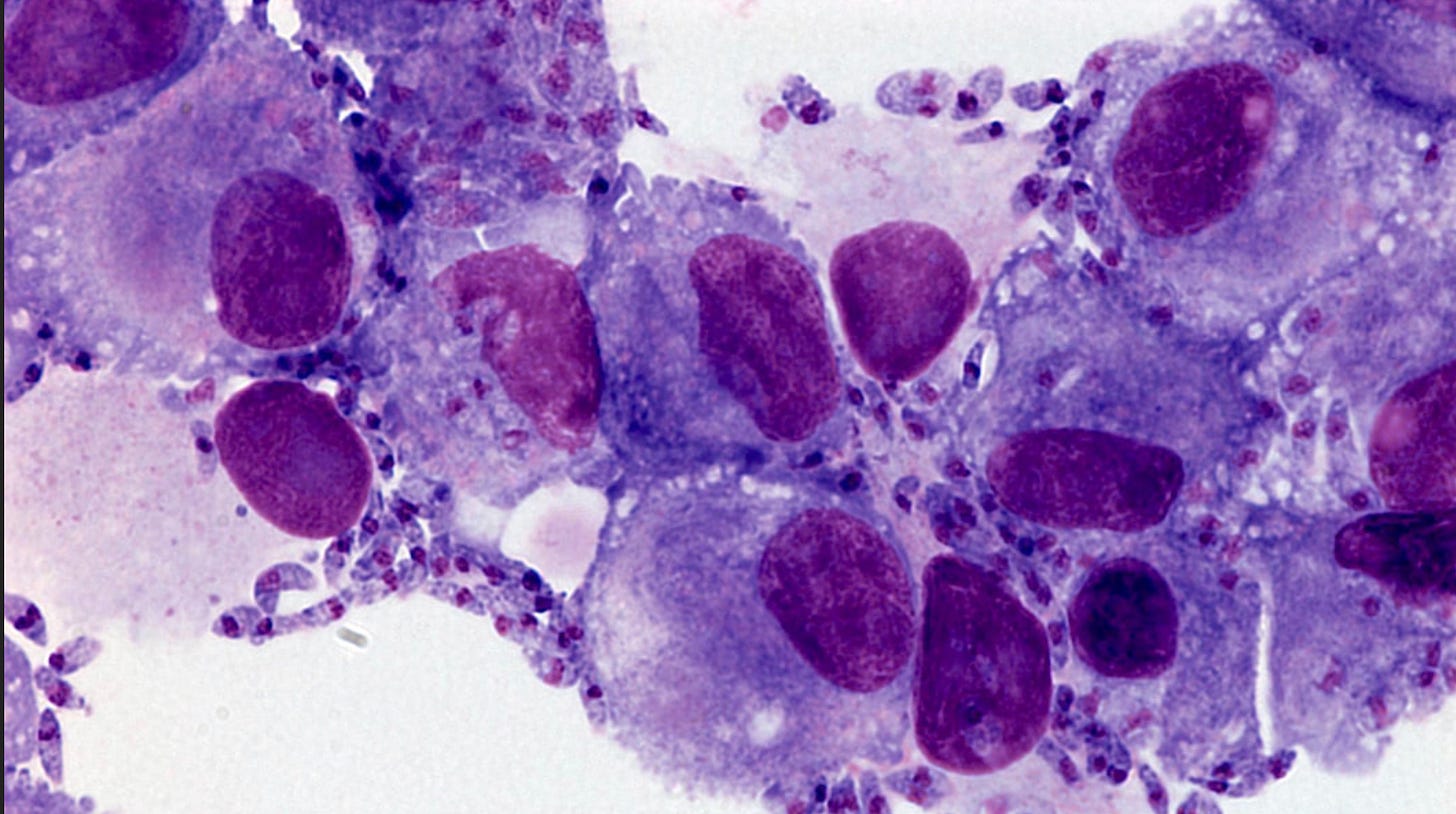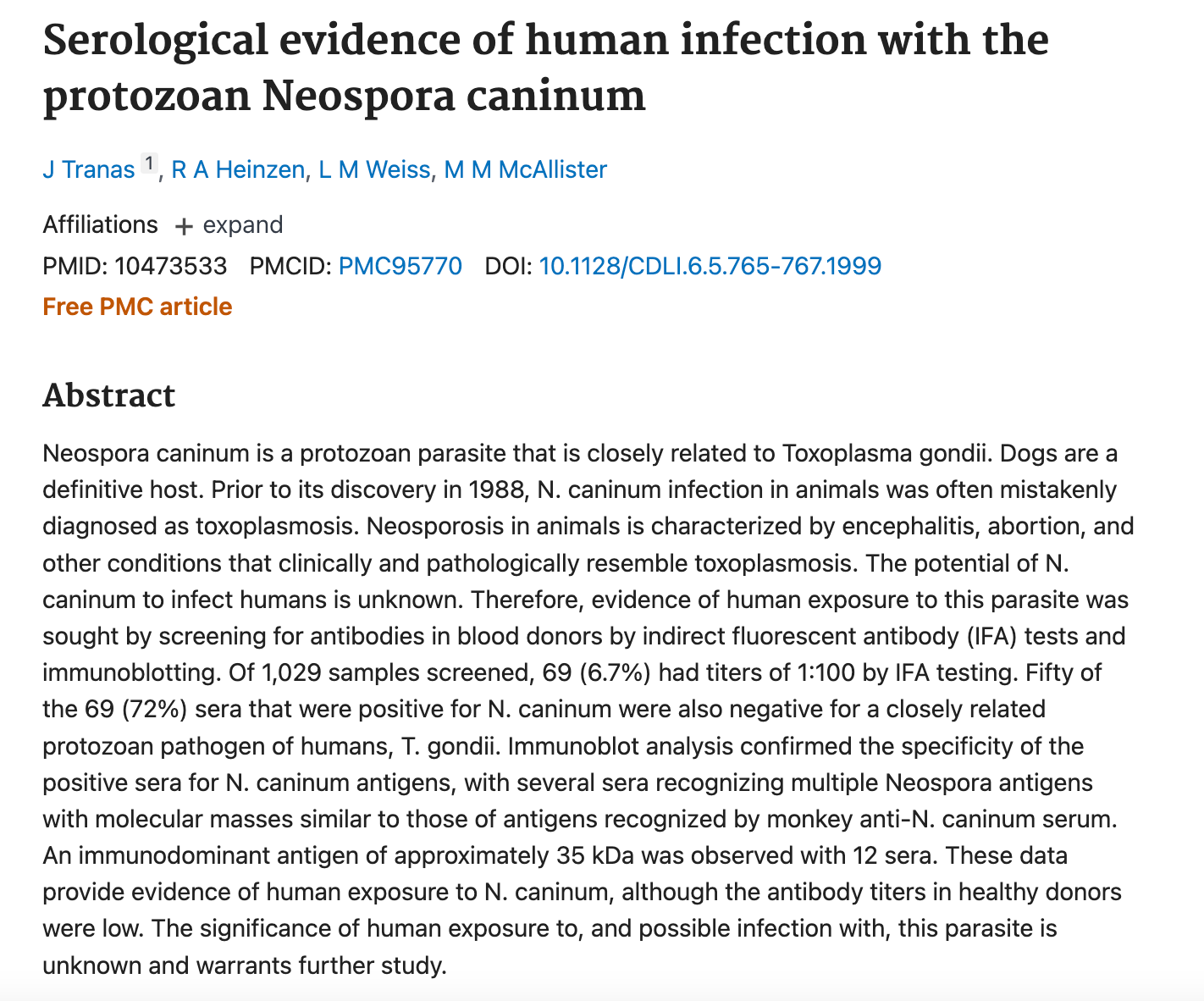Neospora Caninum: A Protozoan Parasite Not to Be Ignored
Watch out for yourself because a team of researchers propose infecting people with this parasite that causes spontaneous abortions in cattle and leg paralysis in puppies, to treat human cancer
This story is a result of many months of thinking and research. It is my private thoughts of a curious person, not medical advice as I am not qualified to give medical advice. :) I believe that we the westerners have a massive problem of protozoan infections. It can be looked at as a philosophical problem but it is a very real medical problem with a detrimental impact that largely flies under the radar.
People in western countries are massively infected by highly pathogenic protozoan organisms while the medical science is mostly counterproductive, arrogant, inaccurate, and far behind. People develop problems (neurological problems, inflammation, dementia, autism, and other illnesses) and get treated from God knows what—while the actual issue keeps being ignored. It may be years before the medical science catches up! It is killing me a little because I think have figured it out, and now I just have to wait for the world to catch up.
An example of a protozoan parasite is Toxoplasma gondii 1—but it is not the only one. That particular parasite is officially very prevalent, with over 30% of Earth’s population infected, with some countries like Germany and France infected at a much higher rate.
The amount of medical misconceptions about this “well-studied” parasite is staggering. Doctors say that once the body fights off the initial infection—and the bug successfully transforms into the tissue cyst form and parks itself somewhere in the eyes or in the brain, the person is “immune” because the antibodies are now there. What a bunch of bollocks! It just means that the bug is in ambush, waiting for any drop in immune defenses to attack in full, while quietly multiplying inside the tissue cysts. (Tissue cysts are formed inside the cells and can potentially contain hundreds of pathogenic organisms, and they can persist for decades.)
The immunity often drops when the person gets old or stressed or perhaps receives an immunosuppressive shot (like a COVID shot). And because toxo can live in any tissue, with a special preference for the eyes and the brain, the range of symptoms can be mysterious and broad. And, because there is a notion that elders are supposed to get dementia or lose their minds, poor elders suffer horribly, horror movie style, while the doctors give them pills against fictitious disease! What a philosophical hell ride.
In humans, this bug is known to exist in two forms. One is the “active” form in which it multiplies quickly, busts cells, occupies new sells, multiplies quickly, busts cells, etc. That form is called “tachyzoites.” The other form is a tissue cyst, there can be hundreds little monsters sitting inside a cyst. The building material that the parasite uses for the cyst is in part “borrowed” from the cell membrane, and so it hides from the immune system well. That form is called “bradyzoites.”
In the bradyzoite form, it almost completely changes its cell surface structure comparing to the tachyzoite form, and so to the host, it’s a new animal of sorts. For that reason, once the parasite converts to tissue cysts, the tachyzoite-specific antibodies start waning, they keep waning and waning, and at some point they wane to almost nil. That is true for both IgG and IgM antibodies that they usually check for when they do blood tests. (The
outdatedclassic view is that the IgG antibodies stay forever but, based on more in-depth literature, it is not the case.) Bradyzoite-specific antibodies may very well be present and detectable all the way through but the typical blood tests don’t check for them.At med schools, the future doctors are taught that toxo tissue cysts are no big deal. Sure, one third of the population lives with them (that’s the official number, and some countries like Germany and France have much higher numbers, like 50%+). But, they say, as long as you don’t have AIDS or something, it’s no big deal. (As far as the fact that a lot of elders develop dementia and go senile, it is unrelated, a mystery, something to do with aging-related spontaneous biochemical processes or mysterious chronic inflammation, for which we have drugs to sell. No guarantee but there are drugs to sell.)
People can catch ‘em from contaminated water, food or soil, from injectable products, from each other (despite the doctors saying that it’s not the case). But as bad as the situation with toxo is, there are other parasites!
This particular story is about a prevalent canine parasite discovered in the 1980s that has every logical sign of being a nasty human infection just like toxo—but the medical experts seem to have their brains in a trance, they don’t follow the logic and insist that a human infection, it is not. Or rather, they are not sure but they believe it’s no danger to humans, even though until 1988, they couldn’t even distinguish it from toxo. Blows my mind.
Neospora caninum
Neospora caninum2 is a protozoan parasite that was discovered in 1984 and officially classified in 1988. Prior to that, due to many similarities in the morphology of the bug and the symptoms, it was confused with Toxoplasma gondii. It is now known to be highly prevalent in dogs around the world 3—as well as in domestic cattle. In dogs, it causes neurological, muscle, and ocular issues. In domestic cattle, it causes spontaneous abortion (‘one of the most important infectious causes of abortions in cattle worldwide”4), which is why it is considered an“economic threat. 5
The definitive hosts, in whom the bug can sexually reproduce, are dogs, wolves, coyotes, etc. When it comes to intermediate hosts, it has been found in many animals, including birds, and there are papers that talk about antibodies against this parasite found in people, too.6
Tachyzoites of Neospora caninum, just like toxo tachyzoites, have been found to transmit through the milk of infected mothers. “Experimentally there is evidence that lactogenic transmission occurs in calves [sheep’s milk and goat milk have been shown to have it], but this mode of transmission has not been demonstrated under natural circumstances in calves or dogs [a very vague phrase, I must say].”7
Oh and in1998, yet another Neospora species, Neospora hughesi, was reported in a horse with equine protozoal myeloencephalitis in California.”8 If you read the referenced paper about the horse version, you will be amazed with the amount of “hypotheticals’ in the official species identification process. There is a lot less precision in “science” than one would hope…
Another quote:
Canine neosporosis has worldwide distribution. It is caused by the apicomplexan protozoan Neospora caninum, which has a similar morphology to T. gondii. Its life cycle is at present incompletely understood. The definitive host is probably a carnivore that sheds oocysts in the feces; the oocysts are ingested by herbivores, in which tissue cysts are formed. As many as 20% of dogs are seropositive, probably infected subclinically and, supposedly, transplacentally during gestation.
Ocular lesions of neosporosis include mild anterior uveitis, retinitis and retinochoroiditis.
Serologic testing (IFA) of serum and CSF is the most commonly used diagnostic method for neosporosis. Most animals with the clinical disease show an increase in IgG titers within 1 to 2 weeks of initial signs. The organism may be observed in cytologic preparations of CSF and tissue fine-needle aspirates. Biopsy specimens examined histopathologically may demonstrate the tachyzoites or the typical thick-walled cysts. PCR analysis may prove the presence of the organism and helps in its differentiation from related organisms.
USDA:
Neospora caninum is a parasite that is best known for causing abortion in cattle and neurologic disease in dogs. It has a complicated life cycle with involvement from many animal species. Wild herbivores and wild canids are thought to act as intermediate and definitive hosts, respectively. Domestic dogs, coyotes, and gray wolves are all confirmed definitive hosts for N. caninum. Studies have shown that at least half the dairy and beef herds in the United States have one or more animals that have been exposed to Neospora. In an infected herd, up to 30 percent of the animals may test positive, and some cows may abort several times. While the cow shows little to no effect of the parasite, it is lethal to fetuses from three months of gestation to term. Cattle can become infected by consuming feed or water contaminated with eggs from the parasite, or grazing on contaminated pastures. These eggs are shed in the feces of domestic dogs, coyotes, and wolves. These animals become infected by eating infected animals, placentas or fetuses. This disease is one of the major reasons farm dogs should not be allowed to eat aborted fetuses, fetal membranes, or dead calves. Recent work in Minnesota has begun to elucidate some data surrounding this disease in the state. In blood samples taken during depredation control trapping by USDA-Wildlife Services in 2004, 8/11 (73%)adult wolves from five counties tested positive for N. caninum. Further, three northwestern Minnesota beef herds that had wolf predation, tested their herds, and documented N. caninum infections in 2005. In 2010, the Minnesota Department of Natural Resources began monitoring the prevalence of various diseases and parasites in wolves, including Neospora. To date, serum samples from 239 wolves throughout MN wolf range indicate a prevalence of 54% for N. caninum. In addition to wolves, domestic canids, fox, and coyote have tested positive for Neosporosis, although prevalence in these species is unknown in Minnesota. Other free-ranging wildlife, including white-tailed deer have been found to be seropositive. For example, in northwestern Minnesota, 44/62 (71%) of deer tested showed evidence of exposure to Neospora caninum. An estimate of the economic impact of this disease in Minnesota cattle herds is not readily available, largely due to an inability to describe the disease burden in the population. However, on an affected farm, several factors would be expected to contribute to the economic burden. These would include abortion rates, stillbirths and neonatal mortality, infertility, increased culling, decreased milk production, and decreased value of breeding stock. In epidemic herds, abortion rates as high as 57% have been reported. Recent concerns have been raised by both Minnesota legislators and Minnesota cattlemen regarding the potential challenges associated with Neosporosis and wolves. In particular, as the management of wolves is moved from the federal government to the state government, there is interest in how new management strategies may impact incidence of this disease. Informed scientific data is needed to better answer these questions in an effort to appropriately inform policy-making. This project aims to collect information about the diverse animal species involved in Neospora transmission through sample collection and testing. When possible, disease prevalence will be calculated. An on-farm risk assessment will be completed on ten farms as part of a pilot study to evaluate the effectiveness and feasibility of the tool. Additionally, surveys will be distributed to veterinarians and producers in Minnesota to gauge their perceptions about Neospora to aid future educational efforts. This work will also help to guide economic analyses surrounding this disease and inform the development of disease transmission models to evaluate risk.
Parallels between the effects of protozoan parasites and the effects of the shots
I have a working hypothesis. I think that injection-enhanced (through immunosuppression) and injection-driven (through contamination) infections can explain some of the “vaccine side effects” in a meaningful way. Yes, yes, there are many things wrong with the shots but this route is one of those wrongs, and it’s not to be downplayed. For example, some of the “shedding” could really be an earthly infection. And at least those two protozoan parasites (Neospora caninum and toxo) seem to transmit through mother’s milk, etc.
Researchers suggest infecting people with a parasite to treat cancer!!
Now, this is Crazytown. When I read it I had to rub my eyes. Based on the (outrageously faulty, in my opinion) notion that Neospora caninum does not infect human beings in any sort of dangerous way, a team of French researchers have proposed infecting people with the parasite to treat cancer!!! What a great idea! Let’s infect human beings with a bug that may cause abortions and will possibly eat their brain!
Background: Microorganisms that can be used for their lytic activity against tumor cells as well as inducing or reactivating antitumor immune responses are a relevant part of the available immunotherapy strategies. Viruses, bacteria and even protozoa have been largely explored with success as effective human antitumor agents. To date, only one oncolytic virus-T-VEC-has been approved by the US Food and Drug Administration for use in biological cancer therapy in clinical trials. The goal of our study is to evaluate the potential of a livestock pathogen, the protozoan Neospora caninum, non-pathogenic in humans [←what is the certaintly based on exactly?!!!], as an effective and safe antitumorous agent.
Methods/results: We demonstrated that the treatment of murine thymoma EG7 by subcutaneous injection of N. caninum tachyzoites either in or remotely from the tumor strongly inhibits tumor development, and often causes their complete eradication. Analysis of immune responses showed that N. caninum had the ability to 1) lyze infected cancer cells, 2) reactivate the immunosuppressed immune cells and 3) activate the systemic immune system by generating a protective antitumor response dependent on natural killer cells, CD8-T cells and associated with a strong interferon (IFN)-γ secretion in the tumor microenvironment. Most importantly, we observed a total clearance of the injected agent in the treated animals: N. caninum exhibited strong anticancer effects without persisting in the organism of treated mice [←are they sure?!!]. We also established in vitro and an in vivo non-obese diabetic/severe combined immunodeficiency mouse model that N. caninum infected and induced a strong regression of human Merkel cell carcinoma. Finally, we engineered a N. caninum strain to secrete human interleukin (IL)-15, associated with the alpha-subunit of the IL-15 receptor thus strengthening the immuno-stimulatory properties of N. caninum. Indeed, this NC1-IL15hRec strain induced both proliferation of and IFN-γ secretion by human peripheral blood mononuclear cells, as well as improved efficacy in vivo in the EG7 tumor model.
Conclusion: These results highlight N. caninum as a potential, extremely effective and non-toxic anticancer agent, capable of being engineered to either express at its surface or to secrete biodrugs. Our work has identified the broad clinical possibilities of using N. caninum as an oncolytic protozoan in human medicine.
And here is a very “encouraging” mainstream media report. I am speechless. There are lots of crazy things that the scientists have done (like nuking an artificial lake in Kazakhstan9 and then discovering that the water was radioactive)—but this suggestion to treat cancer by infecting people with a newly discovered toxo cousin that is causing abortions in cattle and leg paralysis in puppies is just waaaay insane.
It’s a very good time to “do our own research.” Let’s do our own research. We are the ones responsible for our well-being, so let’s do our own research, please.
A note to readers: If you are in the position to do so, I very much encourage you to become a paid subscriber or donate. I love you in any case, but it helps A LOT, and I am in a dire need to get more donations and paid subscribers while keeping my posts free. Thank you from my heart for your support!








Here is a resource that I like for toxo, from Sayer Ji. It's a great starting point, in my opinion. I am pinning this comment.
https://greenmedinfo.com/disease/toxoplasma-gondii-infection
Thank you for presenting this well researched and curated medical information, Tessa.
It seems that an infection becomes more "interesting" when there is a product to sell against it.
Being injected with protozoan parasites as a cancer-treatment does seem like something one would not want to be in clinical-trials of.
How about avoiding processed foods, food additives, and eating fresh vegetables, and 5000 units per day of vitamin-D to lower cancer risk?